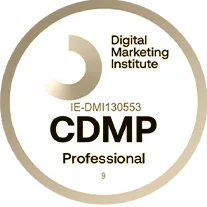
About 31% of advertisers report significant profit gains when using emotional marketing. However, emotional or emotive marketing might seem like a less tangible approach to marketing, as far as ways to measure its success. You’re not just looking at sales or website traffic — you’re delving deeper into sentiment analysis, social media engagement, brand health surveys, and conversion rates. You’re exploring the potency of trigger words through A/B testing, understanding psychographics, and navigating a vast sea of internet comments and user-generated content.
Learn the Importance of Real Human Emotion in a World of AI
Understanding the importance of real human emotion in a world increasingly dominated by AI is crucial in succeeding at emotional marketing. It’s not enough to understand statistics and algorithms; you must also grasp the essence of emotional authenticity. Authenticity is what sets you apart in a sea of AI-generated content.
A computer might analyze data and predict trends, but it can’t replicate the complexities of human emotion. As a marketer, you’re (at least for a while) the only real way to connect businesses to their audiences on a deeper and meaningful level. You’re the one who understands their fears, hopes, and dreams — or at least can actually empathize with them. You’re the one who can make a customer feel seen and heard.
Emotional authenticity in your marketing strategy is a powerful tool. When you’re genuine, your audience knows it. They can sense the difference between an AI-generated message and a message that’s sincerely human. That authenticity is what builds trust, fosters loyalty, and ultimately drives conversions.

Understand Emotional Marketing
To truly leverage the power of emotional marketing, you’ll need to grasp every aspect of it, including its core principles, techniques, and the metrics used to evaluate its effectiveness. Emotional marketing isn’t just about creating compelling ads; it’s about forming connections that resonate with your audience’s feelings, needs, and desires.
Understanding the concept of emotional triggers is crucial. These triggers are elements within your marketing strategy that stir up emotions within your audience. They can be words, images, or experiences that ignite feelings such as happiness, fear, or trust. It’s these emotional reactions that drive consumer actions and decisions.
You must integrate emotional triggers into your marketing strategy carefully. Be sensitive to your audience’s feelings and respectful of their experiences. This isn’t about manipulation; it’s about creating genuine, meaningful connections.
It’s also important to measure the effectiveness of these triggers. Use metrics such as sentiment analysis, conversion rates, and social media engagement to gauge the success of your emotional marketing efforts. By doing so, you’ll gain valuable insights into what resonates with your audience, enabling you to refine your approach.
Analyze Social Sentiment
While you’re striving to connect with your audience on a deeper level, it’s essential to leverage social sentiment analysis, a powerful tool that can reveal how your brand is perceived emotionally online. It’s not just about the number of likes or shares — in fact in our current social climate, likes and shares are hardly a measure of success. You also have to understand the emotions behind the engagement. Are your followers happy, excited, or maybe even upset with your recent post or campaign?
This is where social sentiment analysis comes in. It helps you identify, track, and measure the emotional responses to your brand across various social media platforms. It’s more than just data; it’s about feelings. It’s understanding how your audience feels about your product, your service, or even your latest ad.
Smaller brands that don’t currently have a ton of social commentary can still make use of sentiment analysis. Smaller brands are generally able to connect with more of their audience directly, for one. But you can also monitor the sentiment of larger brands in your niche or industry to help set expectations for what kinds of communication evoke which kinds of emotions.
Deliver Brand Health Surveys
Another tool in your emotional marketing box is the brand health survey. This survey serves as a comprehensive check-up of your brand’s well-being. It’s a great way to measure how well your emotional marketing tactics are working and how they’re affecting your brand perception.
Brand health surveys help you understand how your customers feel about your brand. They reveal your brand’s strengths, weaknesses, opportunities, and threats from the customers’ perspective. By asking questions related to brand loyalty, awareness, and reputation, you can gauge the emotional connection consumers have with your brand.
The beauty of brand health surveys is that they offer insights beyond simple likes or dislikes. They delve into the emotional aspects of brand perception. From these surveys, you can learn if customers associate your brand with positive emotions, such as trust and admiration, or negative ones, such as frustration or disappointment. Tools like Pollfish can be an easy and effective way to conduct these surveys.
Conduct A/B Testing of Your CTA Language
You can also measure the effectiveness of your emotional marketing by running A/B tests on your call-to-action (CTA) language. It’s an effective way to find out which words and phrases resonate most with your audience and drive them to take action. It seems minor, but we’ve seen the language of something as small as a single button increase click-through by 100% or more.
Of course, we know that A/B testing isn’t a one-off experiment. Test everything that makes sense, and test it all of the time. It’s something you should be doing continually to optimize your CTAs and maximize your conversion rates.

Check the Frequency of User-Generated Content
The frequency of UGC (User-Generated Content) is a powerful indicator of your audience’s engagement and emotional connection with your brand. It’s not just about pushing your message out, but also sparking a conversation that resonates with your customers.
The more UGC you see, the more engaged your customers are. They’re not just passively consuming your content; they’re actively participating in the dialogue around your brand. This UGC engagement is a clear sign that your emotional marketing tactics are hitting the mark.
However, it’s not enough to just count the number of posts or comments. You need to dig deeper. Analyze the content, tone, and sentiment of the UGC. Is it positive or negative? Does it reflect the values and emotions you’re trying to evoke with your brand?
Conclusion
By tapping into real human emotions, employing sentiment analysis, conducting brand health surveys, and refining your CTA language, you’re set to amplify your brand’s emotional resonance. When you consider that the “emotional” areas of the brain can process sensory information 20% faster than the cognitive areas, it makes sense to include emotional metrics in your marketing KPIs.

